It’s necessary to know how to repair water damaged bathroom floor in case something happens. You just have to remove the tiles and replace them with a new one.
However, each situation is different. Before doing anything permanent, you have to assess the problem first. You can do this by inspecting the damaged area, the type of flooring you had, and just how bad the situation is.

Keep on reading as we go into more details on how to fix a water-damaged bathroom floor and know if it’s covered by your insurance!
What Are The Signs Of A Broken Bathroom Floor
Uneven or soft flooring
Uneven flooring is when there’s excess moisture in your subfloor. This can cause imbalance and wobble when walking around the damaged surface. Hardwood flooring is a type of flooring vulnerable to water damage.
Musty odor all over the room
Another sign that your bathroom floor is damaged is the unusual smell all over the room, especially when you crouch down. This odor is often produced by mold infestation. It happens when there’s undetected moisture in your subfloor.
Gaps in your bathroom tiles
When you feel like your tiles are buckling under your step, that is a sign of a broken bathroom floor. This movement can result in gaps in your bathroom tiles. If left untreated, it can be a tripping hazard, which can be dangerous, especially if you have children around.
Easy Steps On Fixing A Water Damaged Bathroom Floor
Step #1. Prepare all necessary equipment
Before you start doing anything, carefully prepare all the gears you will need to repair your bathroom floor. Ensure that you have all of your needed tools within your reach to complete your job easier. It would be best to wear protective clothing such as boots, gloves, and a face mask.
Water-damaged bathroom floors most probably will have mold underneath. Breathing in mold spores can result in respiratory problems, allergic reactions, or skin rashes.
Step #2. Inspect the area
When you have all your tools organized, go to your bathroom floor and inspect the area. Look for the spot with uneven flooring and where the water is the deepest. If that affected area didn’t dry for a little bit within 1 to 2 days since it first began, it’s safe to assume that there’s mold underneath.
You should also look at the color of the water leaking. If it’s mostly clear, then that could be clean water. The darker the water is, the dirtier it is.
Step #3. Remove the damaged material
The first thing you’ll have to do before the actual flooring is shutting off your main water valve to prevent any further leakage into the room. Then, detach your toilet as it can get in your way. If you have cabinets that touch the floor, you’d also want to remove them.
Next, take off your flooring and other damaged materials that require fixing. Use a pry bar for removing fasteners and screws. You should also quickly get rid of any debris and try to clean your workspace as much as you can.
Step #4. Repair the subfloor and drywall
When the area is all dried up, this is now the time to install a new subfloor and support framing. You can refer to your old subfloor for the exact measurements. If you have a wooden subfloor, it would be best to replace it with a new one instead of fixing it.
You should also check your drywall and see if there’s any damage on the bottom of your floor. Patch up the affected area and sand it down so that it’s equal to the surrounding wall.
Step #5. Finish up
Once everything is nice and dandy, finish up by reattaching the toilet, cabinets, and bathroom tiles. Ensure that everything is dry before sealing it up so you’ll prevent something like this from happening again.
If there’s mold growth, mix a 50/50 solution of water and vinegar, then spray it to the surface. Wait 30 minutes to an hour before rinsing the area.
Is This Covered By Home Insurance?
If you’re wondering whether your water-damaged floors are included in your insurance coverage, the answer depends on how you got it. Your insurance company may cover the damage for accidental situations. However, it won’t be if the damage is proven to be from neglect.
According to the Insurance Information Institute, wrecked properties due to water damage are among the most expensive disasters your home can experience. That’s why it’s essential to read and understand your insurance policies again to know your financial rights. You could also hire a lawyer to help you with your insurance claims.
Conclusion
When learning how to repair water damaged bathroom floor, it’s important to know how to protect yourself while you’re at it. Wear necessary protective equipment such as gloves and a face mask, especially if you suspect a mold underneath your floors. Mold infestation can be a serious health hazard if exposed for an extended period.
Remember that if you feel like the problem is too serious, there’s no harm in calling experts to do it for you! Sometimes, the next best thing you can do is call for help rather than do more damage when trying to fix it.
